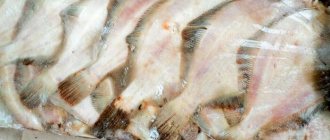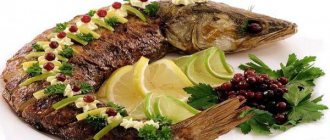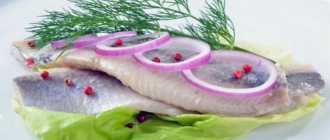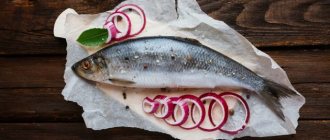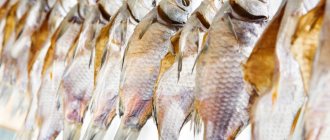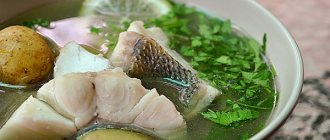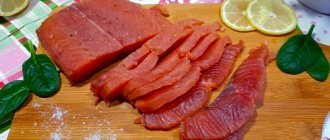How to quickly clean fish from scales
Yes, it takes a lot of time and effort to clean fish from scales, and even more to clean the kitchen after this activity. But I seem to have found a solution to this problem - efficiently, quickly, and the kitchen is in order, I’ll tell you now.
For many years I suffered - I tried everything to scrape it off. Okay, if in the summer: I’ll go out to the garden with basins, fortunately we live in our own house. Everything in the garden is equipped, the water is connected, I drag the table myself and start cleaning - scales fly in all directions, wherever possible.
Honestly, I read about this method, how to easily and quickly clean fish from scales in an apartment, more than 10 years ago in some magazine; I didn’t have the Internet then.
And if this happens in the winter, then you clean so much that you are exhausted in cleaning the kitchen and then washing the towels. It takes a lot of time to clean all my husband's catch.
Glory to the person who came up with this wonderful method... I speeded up the process of cleaning fish from scales, probably 10 times for sure. And now we get to the main thing - the stated topic of the note. Today I am happy to share this recipe with you.
This is the fish I have today, in the photo above. Everything is very simple in fact: you need to take the fish in any way convenient for you (I take it by the eyes) and hold it under a tap with boiling water for 10-20 seconds.
Observe safety precautions: use rubber gloves to avoid being scalded by boiling water.
After this, in one easy movement, without any pressure or tension from the tail, remove the scales from the fish. The scales are removed with great joy, like a feather, without the slightest effort on my part. With one movement, all the scales remained on the knife, as you can see.
What a joy it is not to have to scrape it off the countertops, backsplash and flooring. I use this method for quickly removing scales from fish on any fish: be it river fish or sea fish - it doesn’t matter, in any case my kitchen remains clean. And no cleaning effort is required from me: here are all the scales from one fish, everything is clean all around.
We clean the fish so that scales do not fly off
In order not to clean the entire kitchen from scattered scales, use the instructions
- You can quickly clean the carcass from scales using a regular grater. When cleaning with a grater, the scales do not scatter in different directions. A grater is used to clean fish with hard scales, most often river or lake fish. The carcass is held by the tail and made smooth and at the same time strong movements.
- To prevent the scales from scattering when cleaning the product, the carcass must be immersed in water and cleaned in it. With this method of cleaning, it is better to use rubber gloves, and it is advisable to take gloves with a ribbed surface.
- You can use a bag and clean the product in it, then all the scales will remain in the bag.
- The carcass can be cleaned under running water.
- The product can be cleaned with a regular teaspoon; all the scales will be collected in the spoon.
What are the benefits of river fish?
In fact, it is difficult to overestimate the benefits of perch or chebak freshly caught in the clear waters of the river. This is not store-bought fish, it has lain on the counter for who knows how long, grown on some fish farm and fed with compound feed.
This is a very beneficial product for both adults and children. Such proteins are processed by the body into essential amino acids, which are actively involved in many processes.
Consuming a sufficient amount of protein is necessary for people who perform increased physical work every day - for athletes and those who want not only to lose weight, but also to acquire a toned muscle corset.
Fish has long been used in folk medicine as a remedy. Fish glue stopped hemorrhages, fish oil promoted wound healing, the liver of fatty fish could relieve eyesores, and tench meat was used to treat gout and fever. By the way, in the modern world even medicines are made from fish, such as insulin, pancreatin, compolon.
Vitamin content in fish product:
- Provitamin A is responsible for vision, helps to better navigate in the dark.
- Vitamin D - without it, calcium will not be absorbed, for healthy bones and teeth. It is also useful for the immune system.
- Tocopherol – renews skin cells, synthesizes hormones, for youth and beauty.
- Vitamins B 1,2,3,6,9,12 – benefit the hematopoietic and nervous systems, lower cholesterol and improve immunity, improve memory and mental abilities.
Fish also contains minerals: calcium, iron, magnesium, iodine, phosphorus, zinc, selenium. The easily digestible protein contained in river fish is much healthier than ordinary protein in meat. It’s not for nothing that in Japan people eat mainly fish and live long lives. It also wouldn’t hurt for us to eat 150-200 g of fish - this is the daily norm.
How to clean fish: advice from experienced fishermen
An inexperienced person will need a lot of effort to scrape off the scales. They will fly in different directions and stick to kitchen surfaces. But experienced fishermen have already come up with a lot of options that make it easier to prepare fish for cooking. Here are some options on how to clean fish and leave a minimum of debris:
- Using a serrated kitchen knife, the blunt side of a regular knife, and a fork, process the fish, placed in a plastic bag. It is important to carry out manipulations so that the package does not tear;
- In a sink or deep bowl filled with water, the scales are cleaned using a thin-edged teaspoon. You need to squeeze the fish head with your fingers. The method is good for small fish;
- large scales are handled with a sharp fillet knife. Its blade is inserted from the side of the tail between the scales and the skin. The gradual removal of such a stocking can be lengthy, but guarantees the cleanliness of the kitchen;
- Skin removal with a stocking is carried out starting from the head. After making 2 cuts, grabbing the edge of the skin with pliers, clean the fish. It is recommended to do this on paper or a bag in the kitchen sink;
- the scales slide off evenly after scalding the fish with boiling water on both sides. You can put it in boiling water for a few seconds. The method is good even for very tightly fitting scales. Its disadvantage is that useful substances are lost, although the processing does not particularly affect the taste;
- Using special tools for cleaning fish speeds up the process by 2-3 times. Designs with a small container are especially convenient. The scales are neatly collected there, without clogging the surrounding space;
- The fish with its scales is boiled, removing the skin and separating the bones afterwards.
By choosing one of the listed methods, there is no doubt that the fish will be cleaned of scales efficiently, and the kitchen will delight you with its cleanliness.
Any fish can be cleaned in just 1 minute! Just imagine that 2-3 kg of fish is cleared of scales in less than 5 minutes!
Everyone knows very well that cleaning fish at home in the kitchen is not very convenient. Especially river fish with small scales, for example perch.
Of course, when fishing or in the yard, let the scales fly in different directions. What about at home? The scales can scatter in different directions, and then go and collect them all over the kitchen.
What can you cook from river fish?
An incredible variety of river fish dishes exist in the world, and in Russian cuisine river fish is one of the most important products. Even in ancient times, one of the most important trades for the Slavs was fishing. Therefore, the everyday and holiday table has always been distinguished by a rich variety of fish dishes.
On church holidays such as the Annunciation, the Presentation of the Virgin Mary into the temple and other holidays that occurred during fasting, when the consumption of meat and dairy foods was prohibited, fish dishes occupied a central place on the table.
River catch of “living silver” has always been loved in Rus', but here are just some of the dishes that I learned to cook. And there is still so much to learn, and it’s impossible to list everything...
- Ukha - I know 3 ways to cook it.
- Baked fish in foil in the oven.
- Fried fish is generally a nice thing.
- Stuffed pike is if it is decent in size.
- Fish cutlets - mmm, finger licking good, tender, tender.
- Grilled (we cook it very often in the summer).
- Smoked fish.
How to get rid of scales
To save yourself from the painful process of getting rid of fish scales, you just need to forever remember how to properly clean fish and perform all actions in a certain sequence and following some recommendations:
- If you have recently taken fish out of the freezer, you need to rinse it with water, otherwise it will be slippery. You can additionally sprinkle your hands with salt, this will help hold the fish in your hands. If you still feel uncomfortable, hold the fish with a towel.
- You need to choose a basin or pan in which the whole cleaned fish will fit. If you are very afraid of polluting the kitchen, then you can clean the fish under running water or inside a thick plastic bag.
- If the fish scales are dry, then you need to slightly moisten them and wait until they swell.
- Now you need to cut off the head and fins of the fish (to avoid injury).
- The scales can be removed with different objects, depending on what is more convenient for you: a spoon, fork, knife or a special grater.
- You need to clean the fish against the growth of the scales (in the direction from the tail to the head). It is most effective to make sharp and short movements with your hand. Clean the sides first, then move on to the belly.
- Now all that remains is to rinse the fish and get rid of stuck scales and evaluate the quality of cleaning the fish.
If you are going to salt fish or smoke it, then it is not necessary to clean the scales. This will preserve the maximum amount of natural substances. If you go to a store or market to buy fish, you can buy already cleaned fish there without any problems.
Conclusion
Some husbands clean the catch themselves, while their wives only cook it. With us, this mission rests entirely with me: he will bring the fish, put it in a basin for me, looking as if he had killed a mammoth. The breadwinner! And you, wife, let’s clean it, gut it, and prepare delicious dishes. Fresh food for you, they say, a natural product!
And for as long as we’ve been living with him, since we got married in 1999, I’ve been frowning at the fish my husband caught, because he’s a fisherman. Therefore, both in winter and in summer, and at any moment, as soon as the opportunity arises, he rather runs to go fishing, losing his slippers.
I grumble at him, of course, as without this. It used to bring several kilograms of fish, but what should I do? I always say that all husbands are like husbands - they go fishing to drink vodka. What about him? And he catches it.
My husband is a hereditary fisherman. And his father, it turns out, was a fisherman and his grandfather, and his older brother is also a fisherman.
Dear readers, please use my advice with pleasure: how to clean fish from scales easily and quickly without messing up the kitchen - I hope that it was useful to you. Eat fish and be healthy. Surely you also have some housekeeping tips on how to make life easier at home? Please share your experience in the comments.
Cleaning accessories
The structural features of the fish and the growth of its scales greatly influence the choice of the method of proper and quick cleaning. As an example, consider flounder or mackerel, which are completely devoid of scales. But catfish and burbot have it, although it is very small. But perch and ruffe are generally distinguished by strong scales, and if you don’t know how to clean fish with similar features, then this will really be a difficult process.
Everyone does not like to clean this fish. Very tough scales are usually difficult to process, so most people prefer to peel the skin along with the scales. This greatly simplifies the cleaning process.
The dorsal fin of this predator deserves special attention - it is really very sharp. All you need to do is cut off the fin using scissors or a sharp knife. After this, the process of cleaning pike perch is no different from other fish.
We suggest you read How to get rid of bugs in cereals
Horse mackerel
Horse mackerel also keeps up with perch and pike perch; its scales are no softer than those of other representatives of the fish world. To make the cleaning process easier, simply dip the fish in boiling water. Then the scales will steam and the process of cleaning the fish will be much easier.
Catfish
Catfish is a little more difficult to clean than other fish. First you need to carefully gut the fish, cut off the fins and remove the head. The next step is to fillet the fish. After this, all that remains is to remove the skin from it.
Burbot, eel
Everything here is extremely simple - make a shallow cut around the head of the fish and remove the skin. This process is quite simple, so it does not require any special skills. Burbot liver is a very valuable product, so many people prepare it separately.
Small and dense scales, and even covered with mucus, greatly complicate the cleaning process, so rarely can anyone cope with it the first time. But this is because many people don’t know the basic trick - you need to put the fish in boiling water, and then quickly transfer it to cold water.
The first step is to clean the skin of the river giant from mucus, cut off the fins and remove the offal. Then the skin is simply removed. When cleaning large specimens, it is recommended to cut them into small pieces to make cleaning easier.
First of all, you will need, at a minimum, a knife for cleaning fish. This is the most common option. There is a knife in every home, but all utensils are suitable for cleaning fish. The knife should be comfortable, well sharpened and small. This device removes large scales well.
In modern times, special devices are sold for cleaning fish. In appearance and in their action they resemble a regular grater. The devices have holes into which scales fall during the friction of the fish. Such devices are also well suited for removing small scales. Special boards with a clamp are also sold. As a result, there will be no need to hold the carcass by the tail.
How to quickly clean fish from scales? You can use a regular grater with several edges. It is easy to use. Moreover, the scales are removed in several rows at a time. And they do not scatter to the sides, remaining inside the grater.
You can make a device for cleaning fish yourself. To do this you will need small nails and caps with corrugated edges from glass bottles. And a small tablet. Several covers are nailed to it. This homemade device is suitable for cleaning fish with large scales. In camping conditions, instead of such a device, you can use a tin can by making torn holes in the bottom.
https://www.youtube.com/watch?v=-F_Gobbb73o
How to quickly clean fish from scales? This process is divided into several stages:
- The fish is thoroughly washed in running water. At this time, all debris and mucus are removed from under the scales to avoid the carcass slipping. Each one is washed separately.
- The fish should dry a little for a few minutes so that it does not slip out of your hands. But not for long, as dry scales will scatter throughout the kitchen.
- If the fish has sharp spines or fins, they are cut off in advance with a knife or kitchen scissors.
- The fish lies on a cutting board or other surface. You need to hold it by the tail and peel off the scales towards the head. The carcass should be held tightly. If the fish is small, it will be easier to hold it completely in your hand.
- After cleaning, the fish is washed and the remaining scales are removed with water.
- Evisceration. All fins are removed and the head is cut off. If it remains, then a hole is made at the tail and cut along the belly to the gills. A knife for cleaning fish should be small and sharp. You only need to cut it with the tip so as not to damage the gallbladder. Then all the entrails are removed and discarded, except for the caviar and milk (if needed). The carcass is thoroughly washed under running water.
How to clean river fish from scales? You can remove it in different ways. But the hardest things to clean are perches and ruffs. Therefore, initially all the spiny fins are cut off from the carcasses. The fish is then placed in cold water for a few minutes. Using a fork or knife, make several grooves against the scales.
Roaches have weak scales, but they are difficult to clean because they scatter around the kitchen. Therefore, it is better to clean this fish directly in the pond. At home, it is better to clean it directly under water. It will be enough to put it in the basin. You can sprinkle the fish with salt and rub. Then rinse with water.
For cleaning fish with hard scales, a four-sided grater is best. The carcass is cleaned as usual, from tail to head, against the scales. Pike. Perch and pike perch can be scalded with boiling water before cleaning. Then the scales come off easily. Removable under running water.
To quickly and easily remove the scales, some types of fish, such as perch, are salted in the evening and left in a cool place until the morning. Fish from the freezer does not need to be defrosted completely, an hour is enough. During this time, the scales will thaw and it will be easy to remove.
Some types of fish do not need to be scaled at all. For example, goby or salmon. The carcasses are fried along with the scales, as they are soft and small. The tench is washed in water for a long time before cleaning. If mucus remains on the fish, then the carcass is doused with boiling water. Then the line is washed again under running water. Or the easiest way. The tench is immersed in boiling water for one minute, and then the scales are removed from the carcass directly with the skin.
Everyone faces the common problem of cleaning fish by using the wrong methods. You need to know that this procedure has been carried out since ancient times to this day. Many methods have been invented, and all chefs agree that the classic method of cleaning is relevant and effective.
As a general rule, it is best to clean fish fresh when it has been recently caught or purchased from a store. Only after processing the carcass is placed in the freezer for further storage. It’s better to do the work directly on a pond or in the yard. In this case, you can avoid contaminating the kitchen with scales. How to properly clean fish using the classic method:
- To simplify the task, it is advisable to treat the product with salt - this will prevent it from slipping.
- First, all the fins are removed, but the tail remains in place. The tail is needed to hold the fish, and the fins are cut off in order to avoid injury: there are different specimens and some of them have sharp fins.
- After the fins, start cleaning. Take a long, sharp knife. A large knife makes it easier to remove scales. Next, the fish is placed on a cutting board and held by the tail. Then place the knife on the tail and move it in the direction of the head: you should always clean the fish against the direction of the scales.
- To prevent scales from flying all over the room while working, place a large container of water on the table and place the product there. The same manipulations are performed as in the third point, only under water - this will prevent the scales from scattering.
- After removing all the scales, you should begin gutting. At this step you will have to arm yourself with a narrow knife, but very sharp. Turn the fish onto its back and insert the knife at the base of the head, moving the tool all the way to the lower fin, thereby ripping open the belly. Next, all organs are removed - this can be done either with a knife or with your hand. It's easier to use your hand and pull out everything that's there. Carefully remove the gallbladder.
- After removing the entrails, perform a visual inspection for the presence of caviar. Housewives often find caviar inside fish, which is also healthy and tasty.
- If the selected recipe involves cooking the entire product in the oven, then only the gills are removed.
After the work is done, the fish is washed again under running water.
If you plan to fry the fish in pieces, it must be cut into even pieces. The carcass is placed on a cutting board and the tail and head are removed. Then use a knife to make cuts on the side so that they are the same size, and then cut the product into pieces. First, in the cutting process, you will go through the flesh and encounter a strong backbone.
To remove the fillets, do not gut the fish into pieces, as some housewives do. The product is placed on the workplace - a cutting board. Take the carcass by the tail and cut it in half lengthwise so that the knife blade passes close to the spine. You will get two parts, on one there will be ribs, and on the second - the ribs and ridge. Now remove the bones by scooping them out with a knife. The job is done, cut the finished fillet parts into equal parts.
We suggest you read: How to get rid of unpleasant odor when cooking fish? / cook
The difficulty of cleaning depends on the type of fish. For example, species such as goby and salmon are not cleaned of scales at all. This is due to the small size of the scales, which are also soft. Other specimens are subject to mandatory skin removal, for example: eel, catfish and burbot. You need to make a shallow cut at the base of the head and use a knife to remove the skin. How to quickly clean fish from scales:
- Crucian carp. Such fish can be separated from the scales even with your fingers. It is washed under running water and sprinkled with steamed salt. You need to wait a little time and get to work, running your fingers against the direction of scale growth.
- Pike perch, pike and perch. The fish is placed in a container with boiling water for some time. It all depends on the size of the carcass. The process takes 1-3 minutes. It is important to prevent the product from being overcooked, otherwise the scales will fall off along with the skin and meat.
- Tench. This specimen must be thoroughly washed to remove mucus and mud. For these purposes, running water is used, the carcasses are placed in a container and doused with boiling water. In the process, the stuck mucus coagulates like egg white. Next, repeat washing is performed. Some say that tench scales are so small that they dissolve when cooking fish soup, while others say that it is not recommended to cook carcasses without removing the skin, because small particles will constantly disturb you during the meal.
- Cutting board.
- Kitchen scissors, large.
- Paper towels.
- Sharp knife. If you are not a master, take a regular knife.
- Scraper for cleaning small scales. This device is purchased at retail outlets.
- A grater will also come in handy.
- In general, it is easier to clean fish if it is fresh. Therefore, if your beloved comes from fishing, it is better to start cleaning the entire catch at once and only then put the fish in the freezer for storage. It’s even better to clean the fish right next to the pond - this minimizes the risk of dirtying the kitchen.
- If the fish is very slippery in your hands, sprinkle it with salt. This will make the cleaning process easier.
- Carefully cut off all fins except the tail. Without a tail, cleaning the fish will be much more difficult. The fins are cut off in order to avoid injury - in some species of fish these fins are quite sharp.
- The next stage is cleaning the fish from scales. To do this you need to take a large sharp knife. The larger the knife, the easier it is to clean. Place the fish on a cutting board and grasp the tail with one hand. With your other hand and a knife, remove the scales from the fish, moving from the tail to the head, that is, against the location of the scales.
- If scales are scattered all over the kitchen, you can fill the sink with some water and lower the fish into the water. Clean the scales under water to prevent them from scattering.
- When all the scales have been removed, rinse the fish with water. The next stage is gutting. To do this, take a thin knife that should be very sharp. Spread the belly of the fish from the head to the rear lower fin. Carefully remove the insides of the fish and try to peel off the thin film that covers the inside of the belly. When removing the entrails, be careful with the fish's gall bladder - do not damage it. Otherwise, the fish may acquire an unpleasant bitter taste.
- When gutting, pay attention to the contents of the belly. Sometimes there may be caviar that should not be thrown away under any circumstances.
- If according to a culinary recipe you plan to cook the whole fish (including the head), then you need to remove its gills.
- Don't forget to rinse the fish again after cleaning.
- If you are not going to bake the whole fish, but want to fry it in pieces, then you need to cut it. First, the head and tail are cut off. The remaining part is cut into small slices. Then the fleshy part of the fish is cut, then with a sharp blow of the knife you need to break the spine of the fish at the place of the cut. Then the rest of the fish is cut.
- If you need fish fillet, you should not cut it crosswise into pieces. You need to take the fish by the tail and use a sharp knife to cut off the flesh along the carcass, as close to the ridge as possible. You will get two halves - on one the spine and ribs, and on the second only the ribs. After this, the ribs and large bones are easily removed. Then the fillet is cut into portions into pieces of the required size.
- If you plan to cook fish cutlets, you need to peel the fish along with the bones.
